

The Gold Will Glitter Wherever it is: Convergent Selection in Maize and Rice
Received date: 2022-03-19
Accepted date: 2022-03-21
Online published: 2022-03-24
Domestication of wild plants was crucial for human settlement and the development of civilization, which arose independently in many different geographic areas on different wild species. However, these crops underwent variant domestication process displaying the ‘domestication syndrome’ with a common suite of traits. The systematical analysis of convergent selection at genome level may provide important information and genetic resources for crop breeding. Recently, a team led by Xiaohong Yang and Jiansheng Li from Chinese Agricultural University and Jianbing Yan from Huazhong Agricultural University reported the genetic basis of convergent selection between maize and rice at both single gene and whole genome levels. Particularly, they found the maize KRN2 and rice OsKRN2 genes experienced convergent selection and regulated grain number and yield in a similar pathway. Moreover, they identified a large number of orthologous gene pairs that underwent convergent selection during maize and rice evolution, which were enriched in certain pathways including starch metabolism, sugar and coenzyme synthesis. This significant work not only cloned KRN2/OsKRN2 orthologous gene pairs with great value in maize and rice breeding, but also revealed the convergent selection between maize and rice at the genome level, providing critical foundations for studying the molecular basis of domestication syndrome and their applications in breeding practices.

Key words: convergent selection; domestication; Oryza sativa; Zea mays; grain number
Hong Yu , Jiayang Li . The Gold Will Glitter Wherever it is: Convergent Selection in Maize and Rice[J]. Chinese Bulletin of Botany, 2022 , 57(2) : 153 -156 . DOI: 10.11983/CBB22054
| [1] | Chen QY, Li WY, Tan LB, Tian F (2021). Harnessing knowledge from maize and rice domestication for new crop breeding. Mol Plant 14, 9-26. |
| [2] | Chen WK, Chen L, Zhang X, Yang N, Guo JH, Wang M, Ji SH, Zhao XY, Yin PF, Cai LC, Xu J, Zhang LL, Han YJ, Xiao YN, Xu G, Wang YB, Wang SH, Wu S, Yang F, Jackson D, Cheng JK, Chen SH, Sun CQ, Qin F, Tian F, Fernie AR, Li JS, Yan JB, Yang XH (2022). Convergent selection of a WD40 protein that enhances grain yield in maize and rice. Science 375, 6587. |
| [3] | Doebley JF, Gaut BS, Smith BD (2006). The molecular genetics of crop domestication. Cell 127, 1309-1321. |
| [4] | Gaut BS (2002). Evolutionary dynamics of grass genomes. New Phytol 154, 15-28. |
| [5] | Lin ZW, Li XR, Shannon LM, Yeh CT, Wang ML, Bai GH, Peng Z, Li JR, Trick HN, Clemente TE, Doebley J, Schnable PS, Tuinstra MR, Tesso TT, White F, Yu JM (2012). Parallel domestication of the Shattering 1 genes in cereals. Nat Genet 44, 720-724. |
| [6] | Meyer RS, Purugganan MD (2013). Evolution of crop species: genetics of domestication and diversification. Nat Rev Genet 14, 840-852. |
| [7] | Olsen KM, Wendel JF (2013). A bountiful harvest: genomic insights into crop domestication phenotypes. Annu Rev P- lant Biol 64, 47-70. |
| [8] | Paterson AH, Lin YR, Li ZK, Schertz KF, Doebley JF, Pinson SRM, Liu SC, Stansel JW, Irvine JE (1995). Convergent domestication of cereal crops by independent mutations at corresponding genetic loci. Science 269, 1714-1718. |
| [9] | Sosso D, Luo DP, Li QB, Sasse J, Yang JL, Gendrot G, Suzuki M, Koch KE, McCarty DR, Chourey PS, Rogowsky PM, Ross-Ibarra J, Yang B, Frommer WB (2015). Seed filling in domesticated maize and rice depends on SWEET-mediated hexose transport. Nat Genet 47, 1489-1493. |
| [10] | Wang M, Li WZ, Fang C, Xu F, Liu YC, Wang Z, Yang R, Zhang M, Liu SL, Lu SJ, Lin T, Tang JY, Wang YQ, Wang HR, Lin H, Zhu BG, Chen MS, Kong FJ, Liu BH, Zeng DL, Jackson SA, Chu CC, Tian ZX (2018). Parallel selection on a dormancy gene during domestication of crops from multiple families. Nat Genet 50, 1435-1441. |
| [11] | Yu H, Li JY (2022). Breeding future crops to feed the world through de novo domestication. Nat Commun 13, 1171. |
/
| 〈 |
|
〉 |